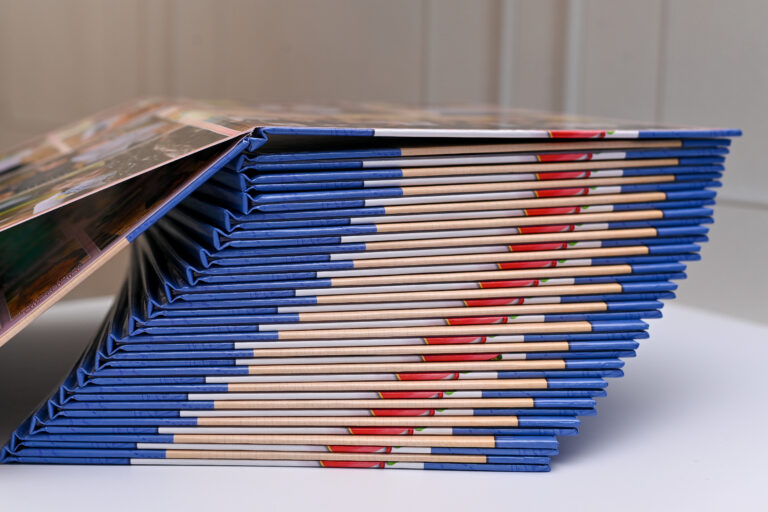Yearbooks used to be a one-size-fits-all product: thick printed books, pages full of posed portraits, and a hefty price tag to match. But in 2025, that model just doesn’t work for everyone—especially with digital-native students, mobile-first parents, and budget-conscious schools.
The yearbook industry is evolving fast. Some publishers are adapting by offering smartphone-friendly digital yearbooks. Others are sticking to tradition with high-end printed options. And a few are doing both—offering platforms that allow schools to customize their own books however they see fit.
Whether you’re a preschool teacher trying to create a keepsake in a few hours, a high school advisor managing a year-long print project, or a principal trying to save costs without cutting corners—this guide breaks down the best yearbook publishers in each category.
Leading the way is YearBoxx, a mobile-first digital yearbook company built for the way families communicate and save memories today. But no matter your format preference, you’ll find the right fit here.
Best Digital Yearbook Publishers
If you want to skip the printing process, cut costs, and give families a shareable, modern memory book—digital yearbooks are the way to go. These companies allow teachers or schools to upload photos, videos, and events into an interactive format that can be accessed anywhere.
1. YearBoxx – The Future of Yearbooks Is Here
Type: 100% Digital
Best For: Schools of any size looking for a modern, mobile-friendly yearbook
Starting Price: $6.99 per student
YearBoxx isn’t just a yearbook—it’s a platform built for memory preservation in the digital age. Instead of printing and shipping bulky books, schools use YearBoxx to create fully digital yearbooks that students and families can view on any smartphone, tablet, or computer.
Unlike some companies that simply upload a PDF version of a print yearbook, YearBoxx is built from the ground up for mobile. Each student gets a private link to their class’s yearbook—featuring photos, events, videos, and more—organized by date or theme. Grandparents can view it instantly. Graduates can keep it forever. No apps. No passwords. No shipping delays.
And for teachers or school admins? It’s fast. Using YearBoxx Create, educators can upload content, organize it, and share the final version in just hours. No more weeks spent formatting layouts or sending files back and forth with designers.
What YearBoxx Offers:
- Built for phones, not print
- Includes photos and video
- Private, secure student links
- No app or downloads required
- Only $6.99 per student
- Lifelong access for families
- Designed in hours with YearBoxx Create
YearBoxx is leading the shift to digital-first yearbooks—and for good reason.
2. Keepsake – Private Photo Books for Small Schools
Type: App-Based, Digital + Optional Print
Best For: Preschool classes, small pods, or homeschool co-ops
Keepsake wasn’t built specifically for schools—but it’s been adopted by thousands of parents and teachers looking to build easy, private photo books for their kids. The app is simple: upload photos, design your book, and either share it digitally or order a physical copy.
While it lacks the collaborative and school-wide features of YearBoxx, it’s perfect for small classrooms or parent-led projects. There’s no minimum order, no commitment, and it works entirely from your phone.
Features:
- Easy-to-use app for phones
- Great for informal or personal yearbooks
- Print optional but not required
- Ideal for families creating books on their own
3. ClassTag Memories – Automatic Digital Yearbooks
Type: Free Classroom Platform Add-On
Best For: Teachers already using ClassTag
ClassTag is best known as a classroom communication tool—but it also includes a memory feed feature that essentially becomes a yearbook over time. Teachers can upload photos, share updates, and post classroom content that is automatically collected into a digital archive.
While it’s not a “yearbook” in the traditional sense, it can function like one for classrooms that already use ClassTag. It’s a great passive way to build a record of the school year without creating something from scratch.
Features:
- No additional cost
- Auto-organizes photos and posts
- Easily shared with parents
- Useful for younger grades or busy teachers
Best Print Yearbook Publishers
While digital yearbooks are gaining ground, print is far from obsolete. For many schools, especially middle and high schools, printed yearbooks remain a beloved tradition. Students love flipping through pages to find signatures, inside jokes, and familiar faces. And parents still appreciate the tangible keepsake that can sit proudly on a bookshelf for decades.
Here are the top print-first yearbook publishers offering quality, customization, and proven experience.
4. Jostens – The Legacy Giant of Yearbooks
Type: Print-first
Best For: Large schools with yearbook committees
Price Range: Varies by school size, design, and order volume
Jostens has been the go-to name in yearbooks for decades. Known for their glossy hardcovers and thick page layouts, they offer a high-end product—though usually at a high-end price. Their platform allows for deep customization, with design software, pre-made layouts, and access to professional guidance.
But with all that quality comes a learning curve and a longer timeline. Jostens is built for schools with yearbook staff, deadlines, and the infrastructure to manage a full yearlong process. For small schools or preschools, it’s likely too complex.
Features:
- Trusted by thousands of schools
- Professional quality, fully customizable
- Offers staff training and resources
- Long delivery timelines
- Works best with large student bodies
5. Lifetouch – Seamless Integration with School Photos
Type: Print-focused with some digital support
Best For: Schools already using Lifetouch for student photography
Price Range: Typically $20–$35 per book
Lifetouch is another major player in the school portrait and yearbook space. Their biggest advantage is integration—if your school already uses Lifetouch for picture day, it’s incredibly easy to pull those photos into a yearbook layout using their platform.
They offer a design tool, templates, and editing help, along with dedicated reps for schools. However, like Jostens, Lifetouch is better suited for schools that plan ahead. It’s a solid option for elementary and middle schools with existing Lifetouch relationships.
Features:
- Integrated with school photos
- Good quality, reasonable pricing
- Strong customer support for schools
- Long design-to-delivery timeline
6. Balfour – Tradition Meets Flexibility
Type: Print-first
Best For: Middle and high schools with custom design needs
Price Range: $25–$60 per book depending on specs
Balfour offers some of the most customizable yearbooks on the market. They cater to schools that want full control over everything from design to paper quality to embossing. Their tools allow schools to design in-house or work with Balfour’s professionals.
What sets Balfour apart is flexibility. They handle small and large orders, offer premium finishes, and support online sales portals for parents. But again, this is a company built for structured yearbook teams. If you’re a solo teacher or a small school, it may be more than you need.
Features:
- Premium customization options
- Works with small and large schools
- Offers parent ordering portals
- Requires time and design effort
Best Hybrid or DIY Yearbook Publishers
Not every school fits neatly into “print” or “digital.” Some want the freedom to design their own yearbooks and decide later how they’ll distribute them—whether that’s printing copies, sending digital PDFs, or both. Hybrid platforms and DIY yearbook tools give educators more control, flexibility, and creativity—especially for schools with small teams or limited budgets.
Here are the top options.
7. Canva for Education – The DIY Designer’s Dream
Type: Digital or Print (Exportable)
Best For: Teachers who want creative freedom
Price: Free for educators
Canva has taken the world by storm with its intuitive drag-and-drop design tools—and it’s just as effective for building yearbooks as it is for social media posts. With Canva for Education, teachers get access to premium templates, fonts, and tools for free.
Start with a yearbook template or build your own from scratch. Add photos, text, and custom pages. You can even collaborate with students, parents, or staff. When it’s done, export it as a digital PDF or print it through Canva’s print service.
Canva is ideal for creative, hands-on schools that don’t mind designing themselves and want complete flexibility in how the book is used.
Features:
- Free for teachers
- Drag-and-drop interface
- Huge selection of templates
- Collaboration features
- Export to PDF for print or digital sharing
8. Shutterfly Yearbooks – Simple and Parent-Friendly
Type: Print with Online Design Tool
Best For: Small schools, PTA projects, and homeschool co-ops
Price: Starting around $15–$25 per book
Shutterfly isn’t a traditional school yearbook publisher—but their easy-to-use photo book platform has made them a favorite for small-scale yearbooks. Parents or teachers can build books online using themed templates, personal photos, and captions. It’s fast, familiar, and doesn’t require approval from a school district or account rep.
Shutterfly is best suited for informal or non-traditional school environments, like parent-led classes, small preschools, or homeschool groups.
Features:
- Easy photo upload and book design
- Familiar, consumer-grade platform
- Print-on-demand (no bulk orders)
- No school contracts or reps
9. TreeRing – Hybrid Platform with Personalization
Type: Print-first, with digital preview
Best For: Mid-sized schools or clubs
Price: Starts at $20 per book
TreeRing brings something unique to the yearbook world: personalized pages. Each student’s book can include two custom pages filled with their own memories and photos—something that sets TreeRing apart from more traditional publishers.
It’s a strong hybrid solution that allows for collaborative yearbook creation while offering options for both physical books and digital previews. The online design tool is school-friendly and doesn’t require advanced design skills.
TreeRing works best for schools that want a printed yearbook but like the idea of adding digital tools and student-driven customization.
Features:
- Personalized pages for each student
- Digital-first design tool
- Environmentally friendly printing
- No order minimums
- Great for modern school culture
10. Mixbook – High-End DIY Yearbooks
Type: Print with Online Builder
Best For: Custom one-off projects or premium designs
Price: $20–$60 depending on book size
Mixbook offers premium-quality photo books that can double as beautiful yearbooks. Their platform gives users full design control, with creative layouts, themed templates, and quality paper choices. Schools with high expectations—or those creating unique graduation books or memory albums—often choose Mixbook when they want to stand out.
It’s not a school-dedicated platform, so you won’t get bulk discounts or classroom tools, but for small teams or end-of-year gifts, it’s a solid option.
Features:
- Premium design and materials
- Easy online book builder
- Creative templates and layouts
- Ideal for boutique or custom yearbooks
How to Choose the Right Yearbook Publisher
With so many options available, choosing the best yearbook publisher depends entirely on your school’s size, goals, and the experience you want to deliver to students and families.
Here are some things to consider when making your decision:
1. Print vs. Digital: What Fits Your Community?
- Print yearbooks are best for schools with strong traditions, larger budgets, and students who enjoy having a physical keepsake.
- Digital yearbooks offer lower costs, easier distribution, and modern features like video support—ideal for mobile-first families and younger students.
- Hybrid platforms allow you to design once and choose whether to go digital, print, or both.
Ask yourself: are your students and parents more likely to treasure a printed book, or would they appreciate a secure, lifelong digital memory that lives on their phone?
2. Time and Team Involvement
- Big names like Jostens or Balfour require a dedicated team, deadlines, and year-long commitment.
- Tools like Canva or YearBoxx Create let a single teacher build something in hours, not months.
- If you’re short on staff or time, digital-first options often offer the most convenience.
3. Cost and Affordability
- Printed yearbooks can run anywhere from $20–$70 per copy, depending on the vendor and customization.
- Digital yearbooks like YearBoxx start at just $6.99 per student, making it one of the most cost-effective solutions on the market.
- Hybrid or DIY tools offer flexibility—but you may end up spending more on print if you’re not careful.
Always factor in who’s paying: the school, the PTA, or the parents?
4. Customization and Long-Term Access
- Do you want students to be able to personalize pages? Look into TreeRing.
- Need multi-language support or ADA compliance? YearBoxx has built-in accessibility features.
- Want something completely one-of-a-kind? Canva and Mixbook give you total creative control.
And don’t forget about accessibility. Digital yearbooks can be shared with family around the world, saved forever, and never lost or damaged.
The Future of Yearbooks Is Personal, Digital, and Accessible
Whether you’re a tech-savvy teacher, a busy school administrator, or a parent leading the yearbook effort for a preschool class—there’s a solution for you in today’s yearbook publishing landscape.
But one option clearly leads the way.
YearBoxx stands out as the only true digital-first yearbook publisher, built specifically for modern students and mobile families. With affordable pricing, video support, instant access, and tools that let you build a book in hours—not weeks—it’s redefining what a yearbook can be.
That said, tradition still has its place, and companies like Jostens, Balfour, and TreeRing continue to offer excellent print-based solutions for schools who want to stick with what they know.
Whatever your path, the most important thing is that your students walk away with memories they can revisit—whether it’s on a bookshelf or on their phone.



